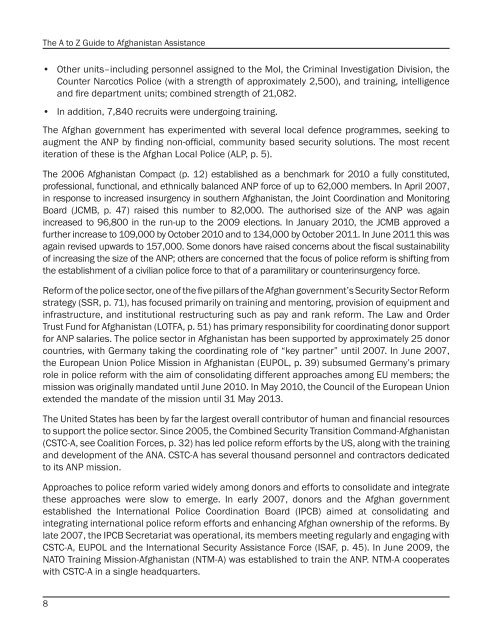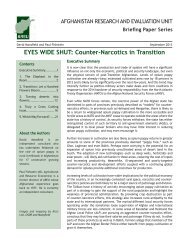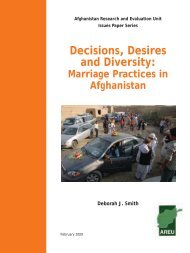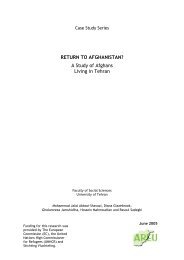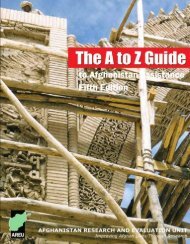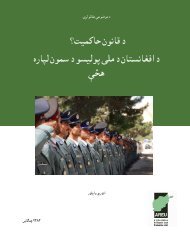A to Z Guide to Afghanistan Assistance 2012 - the Afghanistan ...
A to Z Guide to Afghanistan Assistance 2012 - the Afghanistan ...
A to Z Guide to Afghanistan Assistance 2012 - the Afghanistan ...
Create successful ePaper yourself
Turn your PDF publications into a flip-book with our unique Google optimized e-Paper software.
The A <strong>to</strong> Z <strong>Guide</strong> <strong>to</strong> <strong>Afghanistan</strong> <strong>Assistance</strong><br />
• O<strong>the</strong>r units–including personnel assigned <strong>to</strong> <strong>the</strong> MoI, <strong>the</strong> Criminal Investigation Division, <strong>the</strong><br />
Counter Narcotics Police (with a strength of approximately 2,500), and training, intelligence<br />
and fire department units; combined strength of 21,082.<br />
• In addition, 7,840 recruits were undergoing training.<br />
The Afghan government has experimented with several local defence programmes, seeking <strong>to</strong><br />
augment <strong>the</strong> ANP by finding non-official, community based security solutions. The most recent<br />
iteration of <strong>the</strong>se is <strong>the</strong> Afghan Local Police (ALP, p. 5).<br />
The 2006 <strong>Afghanistan</strong> Compact (p. 12) established as a benchmark for 2010 a fully constituted,<br />
professional, functional, and ethnically balanced ANP force of up <strong>to</strong> 62,000 members. In April 2007,<br />
in response <strong>to</strong> increased insurgency in sou<strong>the</strong>rn <strong>Afghanistan</strong>, <strong>the</strong> Joint Coordination and Moni<strong>to</strong>ring<br />
Board (JCMB, p. 47) raised this number <strong>to</strong> 82,000. The authorised size of <strong>the</strong> ANP was again<br />
increased <strong>to</strong> 96,800 in <strong>the</strong> run-up <strong>to</strong> <strong>the</strong> 2009 elections. In January 2010, <strong>the</strong> JCMB approved a<br />
fur<strong>the</strong>r increase <strong>to</strong> 109,000 by Oc<strong>to</strong>ber 2010 and <strong>to</strong> 134,000 by Oc<strong>to</strong>ber 2011. In June 2011 this was<br />
again revised upwards <strong>to</strong> 157,000. Some donors have raised concerns about <strong>the</strong> fiscal sustainability<br />
of increasing <strong>the</strong> size of <strong>the</strong> ANP; o<strong>the</strong>rs are concerned that <strong>the</strong> focus of police reform is shifting from<br />
<strong>the</strong> establishment of a civilian police force <strong>to</strong> that of a paramilitary or counterinsurgency force.<br />
Reform of <strong>the</strong> police sec<strong>to</strong>r, one of <strong>the</strong> five pillars of <strong>the</strong> Afghan government’s Security Sec<strong>to</strong>r Reform<br />
strategy (SSR, p. 71), has focused primarily on training and men<strong>to</strong>ring, provision of equipment and<br />
infrastructure, and institutional restructuring such as pay and rank reform. The Law and Order<br />
Trust Fund for <strong>Afghanistan</strong> (LOTFA, p. 51) has primary responsibility for coordinating donor support<br />
for ANP salaries. The police sec<strong>to</strong>r in <strong>Afghanistan</strong> has been supported by approximately 25 donor<br />
countries, with Germany taking <strong>the</strong> coordinating role of “key partner” until 2007. In June 2007,<br />
<strong>the</strong> European Union Police Mission in <strong>Afghanistan</strong> (EUPOL, p. 39) subsumed Germany’s primary<br />
role in police reform with <strong>the</strong> aim of consolidating different approaches among EU members; <strong>the</strong><br />
mission was originally mandated until June 2010. In May 2010, <strong>the</strong> Council of <strong>the</strong> European Union<br />
extended <strong>the</strong> mandate of <strong>the</strong> mission until 31 May 2013.<br />
The United States has been by far <strong>the</strong> largest overall contribu<strong>to</strong>r of human and financial resources<br />
<strong>to</strong> support <strong>the</strong> police sec<strong>to</strong>r. Since 2005, <strong>the</strong> Combined Security Transition Command-<strong>Afghanistan</strong><br />
(CSTC-A, see Coalition Forces, p. 32) has led police reform efforts by <strong>the</strong> US, along with <strong>the</strong> training<br />
and development of <strong>the</strong> ANA. CSTC-A has several thousand personnel and contrac<strong>to</strong>rs dedicated<br />
<strong>to</strong> its ANP mission.<br />
Approaches <strong>to</strong> police reform varied widely among donors and efforts <strong>to</strong> consolidate and integrate<br />
<strong>the</strong>se approaches were slow <strong>to</strong> emerge. In early 2007, donors and <strong>the</strong> Afghan government<br />
established <strong>the</strong> International Police Coordination Board (IPCB) aimed at consolidating and<br />
integrating international police reform efforts and enhancing Afghan ownership of <strong>the</strong> reforms. By<br />
late 2007, <strong>the</strong> IPCB Secretariat was operational, its members meeting regularly and engaging with<br />
CSTC-A, EUPOL and <strong>the</strong> International Security <strong>Assistance</strong> Force (ISAF, p. 45). In June 2009, <strong>the</strong><br />
NATO Training Mission-<strong>Afghanistan</strong> (NTM-A) was established <strong>to</strong> train <strong>the</strong> ANP. NTM-A cooperates<br />
with CSTC-A in a single headquarters.<br />
8


